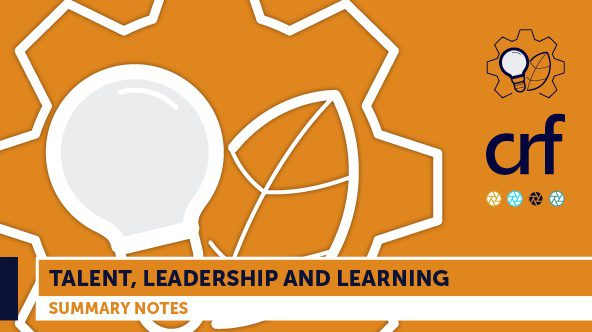Talent, Leadership and Learning
Integrating Careers, Talent and Succession – A Missed Opportunity?
CRF’s recent research Talent: Careers, Development and Succession in a Changing Landscape, considered how to improve the integration between careers and other elements of the talent mix, such as succession planning and talent pools. Succession planning and other talent processes such as talent reviews and talent pools are important elements of career development. Done well, it’s a method of managing careers for some groups of people, whether they are critical talent, senior specialists or future senior leaders. “Succession planning remains essential as a means of developing careers,” said Wendy Hirsh. “Some career trajectories require you to take on a role you haven’t done before, which means you have to be able to orchestrate moves.”
If we think of succession planning as a top-down process and career development as bottom-up, they should join up. However, the reality is that they often don’t fit together. This is reflected in our survey: only 19% of respondents said their approach to succession planning is fairly or highly effective in developing future strategic capabilities required by the business, and only 22% considered their organisation’s succession planning efforts to be fairly or highly effective in preparing potential successors for new roles. This suggests succession plans are not being used as well as they could be to drive the development of critical talent.
How could succession planning practices be improved? Here are some suggestions from our research:
- Identify the capabilities you need to nurture in order to execute the strategy (e.g. digital skills) and build talent pools. For example, Tesco plans succession at job family level rather than role by role. Make sure those who are in talent pools receive differential career support and development. “Developing pools of capability, as the name suggests, should mean that leaders have a broader pool of candidates to consider when roles become vacant. Allowing more choice and flexibility in the way organisations match talent to value,” said Jill Foley. Our survey suggests that talent pools are under-utilised in organisations today: only 33% of organisations consider both individual roles and talent pools in their succession planning, and 9% focus on talent pools only. The majority (58%) focus on individual roles only.
- Focus on roles that are critical for the future of the business, which might include deep technical specialists as well as general managers. Some companies in highly technical fields, such as Ørsted (renewable energy) and Avanade (technology services) are developing technical career tracks so they can attract and retain the critical skills they need at senior level. “It used to be that everything was about the GM role,” said Jessica Foster Head of Executive Bench, RHR International. “But it’s possible that 10% of your growth next year could come from someone who has a background in developing AI, for example. Be careful not to put people in situations that don’t play to their strengths. You risk losing that talent from spaces where they add unique value.”
- It’s essential that the right objective information is on hand when discussions take place. Gather up-to-date information on individual aspirations and make sure it’s searchable. One thing that may encourage people to provide honest and up-to-date information about their plans and motivations is to let them know they are in a talent pool or on a succession plan and that any information they provide will be taken into account. However, our survey found that less than half of respondents (46%) inform people that they are on a succession plan or in a talent pool.
- Focus attention where it’s most needed. “Which roles are likely to turn over in the next 18 months? Those are the ones to pay attention to,” said Jessica Foster. “Too often, succession planning meetings just run through the same information as last time. Focus on the 20% where you might expect movement, not the 80% who aren’t going to move in the next few years.”
- Find ways of flagging and discussing undervalued talent. RHR’s Executive Bench assessment suite flags people who scored highly on its assessments but are ranked lower on the company’s measures. “This can tell you where you are not moving critical talent in your pipeline fast enough,” said Jessica Foster, who runs Executive Bench at RHR. “Those people are probably stuck and you need to do something with them.” Shell proactively looks at a combination of performance ratings, potential and progression information to identify when emerging talent and people with high potential may plateau or need extra support, and flags this so leaders can take action to unlock career moves.
- Get away from check-box approaches to career development, such as the need to have worked in multiple countries and run a P&L. “People will be past it before they can check all the boxes; it’s an absurd waste of talent,” said Foster. One effect of the Covid-19 pandemic is companies are less likely to require people to undertake overseas assignments, although this trend was already underway.
- Make sure conversations focus on planning development actions for people who are on succession plans. Hold leaders accountable for following through on the actions they agree to take. Reward leaders with a track record in moving talent around the organisation. As one of the respondents to our survey commented: “We need to train successors for the future, not just put them on a list.”
This is an extract from CRF’s research report: Talent: Careers, Development and Succession in a Changing Landscape.
MEMBER LOGIN TO ACCESS ALL CRF CONTENT


